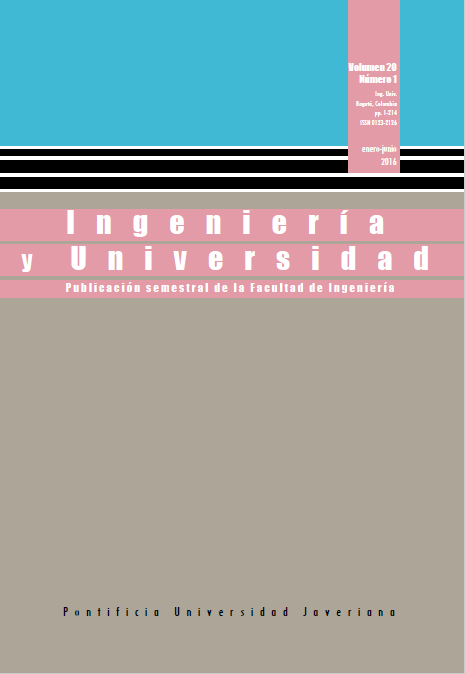Abstract
The comparison between the structured and unstructured models was performed in order to determine the mathematical approach that best fit the biological synthesis of anthocyanins from plant cell cultures. A structured model was used for the production of secondary metabolites using cell cultures of strawberry (Fragaria ananassa) taking into account the cell viability of pigmented and non-pigmented cells. Moreover, growth and anthocyanin production of cell suspensions of grape (Vitis vinifera) were evaluated by an unstructured model. Both models adequately described the growth of plant cells and substrate uptake. However, anthocyanin production is intrinsically related to cell growth, especially degradation thereof; therefore the structured model was selected to describe the production of this secondary metabolite.
[2] G. Wong, Química de los alimentos: mecanismos y teoría. Madrid: Edición A., 1995.
[3] W. Zhang, M. Seki, S. Furusaki, and A. Middelberg, “Anthocyanin synthesis, growth and nutrient uptake in suspension cultures of strawberry cells,” J. Ferment. Bioeng., vol. 86, no. 1, pp. 72–78, 1998.
[4] D.K. Dougall and K.W. Weyrauch, “Growth and anthocyanin production by carrot suspension cultures grown under chemostat conditions with phosphate as the limiting nutrient,” Biotechnol. Bioeng., vol. 22, no. 2, pp. 337–352, 1980.
[5] T.J. Hirasuna, M.L. Shuler, V.K. Lackney, and R.M. Spanswick, “Enhanced anthocyanin production in grape cell cultures,” Plant Sci., vol. 78, no. 1, pp. 107–120, 1991.
[6] W. Zhang, S. Furusaki, and C. Franco, “A two-stage process of temperature-shift for enhanced anthocyanin production in strawberry cell suspension cultures,” Sci. China, pp. 345–350, 1999.
[7] J.-J. Zhong and T. Yoshida, “High density cultivation of Perilla frutescens cell suspensions for anthocyanin production: Effects of sucrose concentration and inoculum size,” Enzyme Microb. Technol., vol. 17, no. 12, pp. 1073–1079, 1995.
[8] J. Guardiola, J.L. Iborra, M. Canovas, and M. Cánovas, “A model that links growth and secondary metabolite production in plant cell suspension cultures,” Biotechnol. Bioeng., vol. 46, no. 3, pp. 291–297, 1995.
[9] D. Drapeau, H. Blanch, and C. Wike, “Growth kinetics of Dioscorea deltoidea and Catharanthus roseus in batch cultures,” Biotechnol. Bioeng., pp. 291–297, 1994.
[10] J. Monod, “The growth of bacterial cultures,” Annu. Rev. Microbiol., vol. 3, p. 371, 1947.
[11] C. Bailey and H. Nicholson, “A new structured model for plant cell culture,” Biotechnol. Bioeng., pp. 1331–1336, 1989.
[12] W. Zhang and S. Furusaki, “Production of anthocyanins by plant cell cultures,” Biotechnol. Bioprocess Eng., vol. 4, no. 4, pp. 231–252, 1999.
[13] W. W. Su and F. Lei, “Rosmarinic acid production in Perfused Anchusa Officinalis culture: Effect of inoculum size,” Biotechnol. Lett., vol. 15, no. 10, pp. 1035–1038, 1993.
[14] G. Patil and K. S. M. S. Raghavarao, “Integrated membrane process for the concentration of anthocyanin,” J. Food Eng., vol. 78, no. December 2005, pp. 1233–1239, 2007.
[15] J. Moncada, M.M. El-Halwagi, and C.A. Cardona, “Techno-economic analysis for a sugarcane biorefinery: Colombian case,” Bioresour. Technol., vol. 135, pp. 533–543, 2013.
[16] Food and Agriculture Organization of the United States (FAO), “Sugar crops and sweeteners and derived products.” [Online]. Available: www.fao.org. [Accessed: 05-Jul-2015].
This journal is registered under a Creative Commons Attribution 4.0 International Public License. Thus, this work may be reproduced, distributed, and publicly shared in digital format, as long as the names of the authors and Pontificia Universidad Javeriana are acknowledged. Others are allowed to quote, adapt, transform, auto-archive, republish, and create based on this material, for any purpose (even commercial ones), provided the authorship is duly acknowledged, a link to the original work is provided, and it is specified if changes have been made. Pontificia Universidad Javeriana does not hold the rights of published works and the authors are solely responsible for the contents of their works; they keep the moral, intellectual, privacy, and publicity rights.
Approving the intervention of the work (review, copy-editing, translation, layout) and the following outreach, are granted through an use license and not through an assignment of rights. This means the journal and Pontificia Universidad Javeriana cannot be held responsible for any ethical malpractice by the authors. As a consequence of the protection granted by the use license, the journal is not required to publish recantations or modify information already published, unless the errata stems from the editorial management process. Publishing contents in this journal does not generate royalties for contributors.


